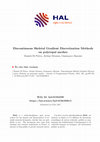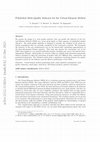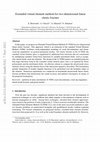Papers by Gianmarco Manzini
This document presents the results of a set of preliminary numerical experiments using several po... more This document presents the results of a set of preliminary numerical experiments using several possible conforming virtual element approximations of the convection-reaction-diffusion equation with variable coefficients.

Advances in Water Resources, Oct 1, 2020
Abstract We explore the coupling of surface and subsurface flows on fully unstructured meshes tha... more Abstract We explore the coupling of surface and subsurface flows on fully unstructured meshes that conform to complex soil structures. To accommodate the distorted meshes that inevitably result from explicit representation of complex soil structures, we leverage the structure of the Mimetic Finite Difference (MFD) spatial discretization scheme to couple surface and subsurface flows. The MFD method achieves second-order accuracy and maintains local mass conservation on distorted meshes. We couple the diffusion wave approximation for surface flows to the Richards equation for subsurface flow, ensuring continuity of both pressure and flux between the surface and subsurface. The MFD method is particularly convenient for this coupling because it uses face-based constraints in the subsurface system that can be expressed as face-pressure unknowns. Those unknowns are coincident with surface cell-based unknowns, thus allowing the discrete surface system to be directly substituted into the subsurface system and solved implicitly as a global system. Robust representation of the transition between wet and dry surface conditions requires upwinding of the relative permeability and is facilitated by globalization in the nonlinear solver. The approach and its implementation in the Advanced Terrestrial Simulator (ATS) are evaluated by comparison to previously published benchmarks. Using runoff from soils with patchy groundcover (duff) as an example, we show that the new method converges significantly faster in mesh convergence tests than the commonly used two-point flux approximation.
We propose a strategy for the construction of monotone schemes in the framework of the mimetic fi... more We propose a strategy for the construction of monotone schemes in the framework of the mimetic finite difference method for the approximation of diffusion problems on unstructured polygonal and polyhedral meshes.
HAL (Le Centre pour la Communication Scientifique Directe), 2021
HAL is a multidisciplinary open access archive for the deposit and dissemination of scientific re... more HAL is a multidisciplinary open access archive for the deposit and dissemination of scientific research documents, whether they are published or not. The documents may come from teaching and research institutions in France or abroad, or from public or private research centers. L'archive ouverte pluridisciplinaire HAL, est destinée au dépôt et à la diffusion de documents scientifiques de niveau recherche, publiés ou non, émanant des établissements d'enseignement et de recherche français ou étrangers, des laboratoires publics ou privés.
Springer eBooks, 2011
The maximum principle is a major property of solutions of partial differential equations. In this... more The maximum principle is a major property of solutions of partial differential equations. In this work, we analyze a few constructive algorithms that allow one to embed this property into a mimetic finite difference (MFD) method. The algorithms search in the parametric family of MFD methods for a member that guarantees the discrete maximum principle (DMP). A set of sufficient conditions for the DMP is derived for a few types of meshes. For general meshes, a numerical optimization procedure is proposed and studied numerically.
WIT Transactions on Information and Communication Technologies, 1970
The concentration equation in the model of miscible flow in porous media, such as appearing in re... more The concentration equation in the model of miscible flow in porous media, such as appearing in reservoir engineering, is treated using unstructured finite volumes, implicit time stepping and domain decomposition. The computational effort can be demanding in particular in strongly heterogeneous reservoirs. A distributed parallel environment might be helpful here. We discuss some performance characteristics for an IBM-SP2.

Journal of Computational Physics, Feb 1, 2018
In this work we develop arbitrary-order Discontinuous Skeletal Gradient Discretisations (DSGD) on... more In this work we develop arbitrary-order Discontinuous Skeletal Gradient Discretisations (DSGD) on general polytopal meshes. Discontinuous Skeletal refers to the fact that the globally coupled unknowns are broken polynomials on the mesh skeleton. The key ingredient is a high-order gradient reconstruction composed of two terms: (i) a consistent contribution obtained mimicking an integration by parts formula inside each element and (ii) a stabilising term for which sufficient design conditions are provided. An example of stabilisation that satisfies the design conditions is proposed based on a local lifting of high-order residuals on a Raviart-Thomas-Nédélec subspace. We prove that the novel DSGDs satisfy coercivity, consistency, limit-conformity, and compactness requirements that ensure convergence for a variety of elliptic and parabolic problems. Links with Hybrid High-Order, non-conforming Mimetic Finite Difference and non-conforming Virtual Element methods are also studied. Numerical examples complete the exposition.
Springer eBooks, 2021
The gradient discretisation method (GDM) is a generic framework for the spatial discretisation of... more The gradient discretisation method (GDM) is a generic framework for the spatial discretisation of partial differential equations. The goal of this contribution is to establish an error estimate for a class of degenerate parabolic problems, obtained under very mild regularity assumptions on the exact solution. Our study covers well-known models like the porous medium equation and the fast diffusion equations, as well as the strongly degenerate Stefan problem. Several schemes are then compared in a last section devoted to numerical results.
In this work we propose a Gradient Discretization framework for the conforming virtual element me... more In this work we propose a Gradient Discretization framework for the conforming virtual element method and the partition of unity method for the Schrödinger equation with pseudopotentials. This formulation works for any order of accuracy on general polytopal meshes.
Mathematical Models and Methods in Applied Sciences, Jul 1, 2008
We consider a class of residual-based stabilization schemes (including the one using wavelets) fo... more We consider a class of residual-based stabilization schemes (including the one using wavelets) for the three fields formulation of domain decomposition of elliptic boundary value problems. These schemes can be incorporated in the plain three fields formulation as an a posteriori correction that is performed at each iteration of the numerical resolution process. The crucial point is that this approach does not require any modification to the sub-domain solvers. This fact makes it possible to design an efficient numerical algorithm that solves the discrete problem resulting from the stabilized method. We demonstrate the effectiveness of this approach by several numerical experiments that also show the low computational complexity of the stabilized method and its good dependence on the stabilization parameter.

Calcolo
We propose a quality-based optimization strategy to reduce the total number of degrees of freedom... more We propose a quality-based optimization strategy to reduce the total number of degrees of freedom associated with a discrete problem defined over a polygonal tessellation with the Virtual Element Method. The presented Quality Agglomeration algorithm relies only on the geometrical properties of the problem polygonal mesh, agglomerating groups of neighboring elements. We test this approach in the context of fractured porous media, in which the generation of a global conforming mesh on a Discrete Fracture Network leads to a considerable number of unknowns, due to the presence of highly complex geometries (e.g. thin triangles, large angles, small edges) and the significant size of the computational domains. We show the efficiency and the robustness of our approach, applied independently on each fracture for different network configurations, exploiting the flexibility of the Virtual Element Method in handling general polygonal elements.
SEMA SIMAI Springer series, 2022
In this work we report some results, obtained within the framework of the ERC Project CHANGE, on ... more In this work we report some results, obtained within the framework of the ERC Project CHANGE, on the impact on the performance of the virtual element method of the shape of the polygonal elements of the underlying mesh. More in detail, after reviewing the state of the art, we present a) an experimental analysis of the convergence of the VEM under condition violating the standard shape regularity assumptions, b) an analysis of the correlation between some mesh quality metrics and a set of different performance indexes, and c) a suitably designed mesh quality indicator, aimed at predicting the quality of the performance of the VEM on a given mesh.
Mathematical Models and Methods in Applied Sciences
We present a four-field virtual element discretization for the time-dependent resistive magnetohy... more We present a four-field virtual element discretization for the time-dependent resistive magnetohydrodynamics equations in three space dimensions, focusing on the semi-discrete formulation. The proposed method employs general polyhedral meshes and guarantees velocity and magnetic fields that are divergence free up to machine precision. We provide a full convergence analysis under suitable regularity assumptions, which is validated by some numerical tests.

Computers & Mathematics with Applications, 2022
We present the design of a mesh quality indicator that can predict the behavior of the Virtual El... more We present the design of a mesh quality indicator that can predict the behavior of the Virtual Element Method (VEM) on a given mesh family or finite sequence of polyhedral meshes (dataset). The mesh quality indicator is designed to measure the violation of the mesh regularity assumptions that are normally considered in the convergence analysis. We investigate the behavior of this new mathematical tool on the lowest-order conforming approximation of the three-dimensional Poisson equation. This work also assesses the convergence rate of the VEM when applied to very general polyhedral meshes, including non convex and skewed threedimensional elements. Such meshes are created within an original mesh generation framework, which is designed to allow the generation of meshes with very different sizes, connectivity and geometrical properties. The obtained results show a significant correlation between the quality measured a priori by the indicator and the effective performance of the VEM.

The virtual element method (VEM) is a stabilized Galerkin formulation on arbitrary polytopal mesh... more The virtual element method (VEM) is a stabilized Galerkin formulation on arbitrary polytopal meshes. In the VEM, the basis functions are implicit (virtual)-they are not known nor do they need to be computed within the problem domain. Suitable projection operators are used to decompose the bilinear form at the element-level into two parts: a consistent term that reproduces a given polynomial space and a correction term that ensures stability. In this study, we consider a low-order extended virtual element method (X-VEM) that is in the spirit of the extended finite element method for crack problems. Herein, we focus on the two-dimensional Laplace crack problem. In the X-VEM, we enrich the standard virtual element space with additional discontinuous functions through the framework of partition-of-unity. The nodal basis functions in the VEM are chosen as the partition-of-unity functions, and we study means to stabilize the standard and enriched sub-matrices that constitute the element stiffness matrix. Numerical experiments are performed on the problem of a cracked membrane under mode III loading to affirm the accuracy, and to establish the optimal convergence in energy of the method.

SEMA SIMAI Springer series, Apr 8, 2021
In this work, we review the framework of the Virtual Element Method (VEM) for a model in magneto-... more In this work, we review the framework of the Virtual Element Method (VEM) for a model in magneto-hydrodynamics (MHD), that incorporates a coupling between electromagnetics and fluid flow, and allows us to construct novel discretizations for simulating realistic phenomenon in MHD. First, we study two chains of spaces approximating the electromagnetic and fluid flow components of the model. Then, we show that this VEM approximation will yield divergence free discrete magnetic fields, an important property in any simulation in MHD. We present a linearization strategy to solve the VEM approximation which respects the divergence free condition on the magnetic field. This linearization will require that, at each non-linear iteration, a linear system be solved. We study these linear systems and show that they represent well-posed saddle point problems. We conclude by presenting numerical experiments exploring the performance of the VEM applied to the subsystem describing the electromagnetics. The first set of experiments provide evidence regarding the speed of convergence of the method as well as the divergence-free condition on the magnetic field. In the second set we present a model for magnetic reconnection in a mesh that includes a series of hanging nodes, which we use to calibrate the resolution of the method. The magnetic reconnection phenomenon happens near the center of the domain where the mesh resolution is finer and high resolution is achieved.
Computers & Mathematics with Applications, 2021
We present a low order virtual element discretization for time dependent Maxwell's equations, whi... more We present a low order virtual element discretization for time dependent Maxwell's equations, which allow for the use of general polyhedral meshes. Both the semi-and fully-discrete schemes are considered. We derive optimal a priori estimates and validate them on a set of numerical experiments. As pivot results, we discuss some novel inequalities for de Rahm sequences of nodal, edge, and face virtual element spaces.

Computer Methods in Applied Mechanics and Engineering, 2021
In this paper, we propose an eXtended Virtual Element Method (X-VEM) for two-dimensional linear e... more In this paper, we propose an eXtended Virtual Element Method (X-VEM) for two-dimensional linear elastic fracture. This approach, which is an extension of the standard Virtual Element Method (VEM), facilitates mesh-independent modeling of crack discontinuities and elastic crack-tip singularities on general polygonal meshes. For elastic fracture in the X-VEM, the standard virtual element space is augmented by additional basis functions that are constructed by multiplying standard virtual basis functions by suitable enrichment fields, such as asymptotic mixed-mode crack-tip solutions. The design of the X-VEM requires an extended projector that maps functions lying in the extended virtual element space onto a set spanned by linear polynomials and the enrichment fields. An efficient scheme to compute the mixed-mode stress intensity factors using the domain form of the interaction integral is described. The formulation permits integration of weakly singular functions to be performed over the boundary edges of the element. Numerical experiments are conducted on benchmark mixed-mode linear elastic fracture problems that demonstrate the sound accuracy and optimal convergence in energy of the proposed formulation.

Computer Methods in Applied Mechanics and Engineering, 2021
We present a virtual element method (VEM) for the numerical approximation of the electromagnetics... more We present a virtual element method (VEM) for the numerical approximation of the electromagnetics subsystem of the resistive magnetohydrodynamics (MHD) model in two spatial dimensions. The major advantages of the virtual element method include great flexibility of polygonal meshes and automatic divergence-free constraint on the magnetic flux field. In this work, we rigorously prove the well-posedness of the method and the solenoidal nature of the discrete magnetic flux field. We also derive stability energy estimates. The design of the method includes three choices for the construction of the nodal mass matrix and criteria to more alternatives. We present a set of numerical experiments that independently validate theoretical results. The numerical experiments include the convergence rate study, energy estimates and verification of the divergence-free condition on the magnetic flux field. All these numerical experiments have been performed on triangular, perturbed quadrilateral and Voronoi meshes. Finally, We demonstrate the development of the VEM method on a numerical model for the Hartmann flow.








Uploads
Papers by Gianmarco Manzini